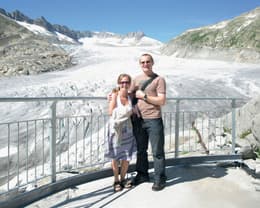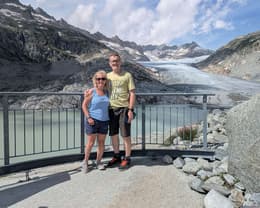
Back Market uses functional cookies required for browsing this site. We and our partners also use cookies that allow us to measure traffic and show you personalized content and ads rather than basic shiz. Think sea salt chocolate chunk vs. oatmeal raisin.
Except for cookies that are essential for navigating our site, we use these cookies and share your data only with your consent. Learn more about cookies. You can change your mind and modify your choices at any time by going to the "Cookies and privacy settings" section at the bottom of any page. Read our Cookie policy and Data Protection Policy for more info.
Why breaking up with fast tech is crucial for the planet’s future
Updated on 16 April 2025
16 April 2025
10 mins read
Issey Gladston
Journalist
Last year, environmentalist Duncan Porter posted two images of the Rhone Glacier on Twitter. Captured 15 years apart, the same glacier, once covered in ice, had completely melted. Little did he know this post would have such a profound reaction from the public and spark important questions about the climate crisis.
Environmentalist Duncan Porter went viral last summer for something surprisingly simple, posting holiday photos with his wife. Except these holiday photos captured something startling. Taken in front of Switzerland’s shrinking Rhone Glacier, they highlight the realities of climate change over 15 years. Garnering global attention, these everyday images sparked important questions about the climate crisis.
Now, Duncan’s imagery is a focal part of Back Market’s latest campaign to end fast tech. While the dangers of fast fashion have been widely discussed for years, fast tech – the system of overproduction and overconsumption of electronic products – has been relatively ignored. This Earth Month, we’re changing that.
Like fast fashion, fast tech thrives on disposability, pushing consumers into an endless upgrade cycle with devices designed to become obsolete within years. Right now, there are 16 billion smartphones in circulation worldwide (that’s 2 per person), and that number is only growing. Since 2010, global e-waste production has increased by 82% and only 22.3% of it can be formally recycled. If we carry on our current trajectory, fast tech’s impact will be responsible for 14% of global emissions by 2040. We need to reduce how much e-waste we create and we need to do it quickly.
Feeling overwhelmed? Well, don’t be, because there are things you can do to be part of the solution to this endless stream of consumption. Instead of reaching for the next upgrade, think about keeping already-produced tech in the market by repairing and caring for what you already have and when you need a new one, buy refurbished.
To kick off the campaign we spoke with Duncan to talk about climate advocacy, the realities of e-waste, and going viral.
Rhône Glacier, Switzerland, 2009

Rhône Glacier, Switzerland, 2024

Hi Duncan, thanks for joining me today to talk about the campaign with Back Market. Can you tell me what it was like returning to the glacier and seeing such a significant change?
There was quite a complex mix of emotions really. We expected the glacier to be a little bit smaller, but stepping out around the corner and seeing it so far back into the distance was quite distressing.
Glaciers usually change over centuries or millennia so to see this drastic change in front of us brought a sense of loss and a sense of grief. I was listening to a podcast yesterday and it was talking about solastalgia, the idea of feeling homesick when you’re still at home because the environment you’re used to is changing in distressing ways and I could really connect to that. There was a real sense of solastalgia, particularly because the original photo we took has been hanging in our kitchen for 15 years. We had this picture in our head of how the glacier was years ago so seeing it again was quite profound.
As a tourist, you have a clear memory of the glacier in its previous state. How did it feel when you put the photos side by side?
It's so easy for your memory to create these false pictures, especially when you've not been somewhere for a while, so actually being presented with that evidence in front of you confirms the difference is upsetting. Thinking about 15 years into the future at the current rate of retreat it doesn't feel very long before an amazing, mighty glacier like the Rhone Glacier will be gone.
Climate change can feel abstract, but your photo makes it more tangible. Why did you decide to post the photos on Twitter?
I remember feeling quite helpless after seeing the glacier and thinking like, what do I do with this? How can I unpack this? When I posted it, I thought it might be useful for a small handful of people I know who work in sustainability. The next day, when I suddenly saw that I had a ridiculous amount of notifications in the morning, I turned my phone off. By the time I turned my phone back on after lunch, the post had about four and a half million views.
I had no intention for it to be as big a thing as it was. I'm glad it was because climate communication is so tricky. One of the things I’ve learned is that at an individual level or at an organisational level it's all about stories, isn't it? You need to tell a story and the story needs to be simple.
Briksdalsbreen Glacier, Norway, 2011

Briksdalsbreen Glacier, Norway, 2022

Is that why you think people resonated with it so much? Why do you think that it went viral?
I think social media is a difficult beast to tame, isn't it? My instinct when those pictures went viral was like surely someone's done this before. It felt so obvious and it didn't feel like I was doing anything particularly unique, but there was something about those photos that really captured people's imagination. It was like capturing lightning in a bottle, really, in terms of that picture and that message of that moment.
I certainly didn’t spend any time really thinking about what my message was. It was an authentic moment of sharing a complex set of emotions with people around me and maybe that was the thing that really connected with people, maybe the authenticity. It wasn't trying to get engagement or likes. It was just me saying how I felt at the time.
And from this experience of going viral, do you think it's changed your perspective on climate advocacy, like how we get people to care and how we bring people on board?
Yes. It really highlights the importance of the story. When I started getting involved in this stuff, it was so easy to hit people with facts about how bad things are but actually telling a story and making the story simple has really changed the way I communicate with people. I'm always thinking, what is the story? What are we talking about here? You know, how can we simplify this?
“The reason that this fast tech paradigm is with us is because we're being told that you need the best, greatest new phone… I think it's fantastic to have a company like Back Market that can show that you can make a business that doesn't rely on this constant upgrade cycle.”
You mentioned you’ve been working in the sustainable sector and you work very closely with an organisation called Protect Earth. How did you get involved with that and what does that organisation do?
Protect Earth is a really amazing little charity. I became friends with Phil who started it and runs it, through tech and bikes and he is an uncompromising force of nature in terms of his climate advocacy. With Protect Earth, he started at a very grassroots level to work with a couple of local landowners to help them rewild, and reforest and it expanded out from there.
Every winter in the tree planting season, we'll plant tens of thousands of trees working with other groups and organisations, which is great fun. You’ll be working all day and lose track of what you've done but then you turn around and look behind you and there's a few thousand trees planted. It's extraordinary to look back and feel that you've actually done something physical and meaningful, and you can go back to it year after year and see this change that you've been able to make.
I think that's such a lesson to people about getting involved in grassroots organisations and activism, it’s just about combining the things you like with the people you like! What's great about this campaign is that you’re presenting this stark imagery alongside empowering people to do something quite simple to tackle the climate crisis. What does it mean to you to partner with Back Market and be part of the campaign?
The reason that this fast tech paradigm is with us is because we're being told that you need the best, greatest new phone or games console or TV and you have to replace these things because it drives money to these companies, drives money to the shareholders. I think it's fantastic to have a company like Back Market that can show that you can make a business that doesn't rely on this constant upgrade cycle. I'm delighted to be a part of helping them to propagate that message.
Companies will deliberately make their stuff difficult to service and they will make it hard to get hold of spare parts. But I think that the changing consumer attitudes towards this is a really critical part of stopping people. I am very keen to see a system that focuses more on reuse and repair before we reconsider replacing things.
Victoria Falls, Zimbabwe, 2012

Victoria Falls, Zimbabwe, 2019

Before being involved in this campaign, did you know much about the impact of e-waste on the planet and sustainability?
I previously worked in a travel company and the sustainability manager who worked there was very keen on reusability and recycling, to the point where if we bought laptops for staff, we would try to get a reconditioned laptop first. But also in my village, we have a repair cafe where there are people with the knowledge and enthusiasm to fix stuff who are fixing electronic goods for other people, which I would love to see spread out across other communities. I think it's fantastic.
Has being part of this campaign changed the way that you think about technology and sustainability? Or has it strengthened things that were already there?
I will be really honest, modern life is quite complicated, isn't it? You're overwhelmed by stuff all the time, so I hadn't really thought much about where I bought my tech, but learning what Back Market does really opened my eyes to the fact that there are companies out there that do this. It's very easy to buy secondhand electronics on eBay but if it's broken or if it's got a problem with charging that you didn't spot when you bought it, you're stuck with it.
Having companies like Back Market who will do professional repair and warranty these things is amazing. I think that really changes the situation. You can buy that stuff with confidence. And I think the confidence side of things is what's been lacking. I think it has changed my outlook a bit in terms of where I want to buy stuff from in the future.
How do you feel about the future? Are you hopeful that we can reverse some of the environmental damage?
It's so easy to put your head in your hands and just think what are we going to do but one of the big successes that I think I've had over the years, in terms of the advocacy I've been doing, is connecting people. Every month we’ll get a bunch of tree people and then try and bring other new people in, and those new people suddenly meet those people and a conversation takes place, the next thing you know they're doing something between their organisations.
Finally, what would you say to someone who is thinking about fast tech and who is considering buying something that's refurbished, but is still feeling a little bit uncertain?
I think you need to take a bit of a step back and think, do I really need this? There's a real joy in feeling like you've fixed something or you've kept something working for longer just avoiding buying stuff and actually keeping stuff going. It can be immensely satisfying once you detach yourself from that hedonic treadmill of needing the next best thing.

Written by Issey Gladston, Journalist
Issey Gladston is a climate journalist, the co-founder of Hothouse Bookclub, and the brain behind the podcast Sexy Climate Change. She was spotlit in the Evening Standard’s Under-30 Eco Activists on a Mission to Save London.
